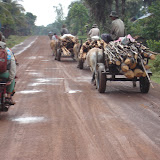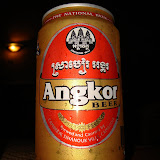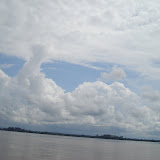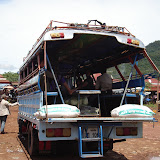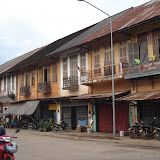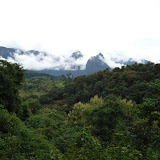El tercer dia fuimos aver algunos templos que estan bastante mas lejos que los de los dos dias anteriores: Banteay Samre (tal vez uno de los mejor restaurados), Kbal Spean (cuya particularidad es que se trata de esculturas y bajorrelieves en el lecho de un rio en medio de la selva), Banteay Srei, que tiene los bajorrelieves mas impresionantes de toda el area, y Beng Mealea, un enorme complejo colapsado en medio de la maleza. Dadas las distancias, era muy ambicioso intentar visitarlos todos en un dia, aun haciendolo en coche, pero queriamos tener un ultimo dia libre, asi que nos lanzamos al desafio, y peor, no lo hicimos en automovil sino en tuk-tuk, a pesar de las advertencias de que habria caminos impracticables para dicho vehiculo. Vimos los primeros dos templos con nuestra lentitud habitual, pero cuando entrabamos al tercero, el conductor del tuk-tuk nos advirtio que si no lo haciamos mas rapido no tendriamos tiempo para ver el ultimo. El problema es que Banteay Sreai, por la extrema delicadeza y los increibles detalles de sus bajorrelieves, es realmente uno de los highlights de Angkor, asi que sobre todo este en particular no queriamos verlo con prisa. Salimos de alli a las tres de la tarde, y el conductor nos dijo que habia dos horas de camino hasta Beng Mealea y que ademas cerraba a las cinco, es decir, mision imposible! Pero el no estaba del todo seguro acerca de la hora de cierre, y nosotros no queriamos volver al otro dia y pagar de nuevo por la excursion, y sobre todo, no queriamos perdernos de ninguna manera este templo, asi que mientras discutiamos entre nosotros que hacer (porque tampoco tenia mucho sentido hacer dos horas mas de camino, mas el regreso, para encontrarse con las puertas cerradas), el conductor apretaba el paso tanto que temiamos incluso por la integridad del tuk-tuk. Y para empeorar las cosas, empezo a llover de manera torrencial, y nuestro conductor preguntaba a todo el que encontraba si ese era el camino correcto porque, descubrimos luego, era la primera vez que hacia esta parte de la ruta! Cuando ya solo esperabamos que en medio de la lluvia el tuk-tuk se partiera en dos y tuvieramos que pasar la noche junto al camino, ocurrio el milagro: llegamos sobre las cuatro y media, cerraban una hora mas tarde, y ademas dejo de llover, asi que no solo teniamos tiempo suficiente sino que eramos los unicos visitantes del templo! Eso si, el regreso no fue facil porque oscurecio pronto y llovio de nuevo, asi que las mas de dos horas de vuelta parecian no terminar nunca. Nuestro conductor, que iba apenas protegido por un poncho, no perdia su optimismo caracteristico ni su sonrisa, y de vez en cuando nos preguntaba “estan dormidos?” Al final llegamos sanos y salvos, y el se hizo merecedor de una buena propina! /
Am dritten Tag wollten wir die weiter entfernten Tempelruinen anschauen. Wie immer versuchten wir soviel wie moeglich in einen Tag zu quetschen und hatten eine Megatour vor. Eigentlich war die Tour mit einem Taxi geplant, da es zuerst hiess, dass der Weg nicht fuer Tuk Tuks geeignet ist und zu weit waere. Aber letztendlich hiess es, dass es doch in Tuk Tuk moeglich sei und zum halben Preis, den uns das Taxi gekostet haette. Also gingen wir darauf ein und starteten frueh mit unserem netten Tuk Tuk Fahrer. Zuerst schauten wir uns den komplett restaurierten Tempel von Banteay Samre an. Dann ging es zum Flussbett der Tausend Linga, Kbal Spean genannt. Von dort aus fuhren wir zu den herrlich delikaten Skulpturen im Tempel von Banteay Srei. Wir hatten geplant danach von diesem Tempel aus zum weiter entfernteren Beng Mealea Tempel zu fahren. Wie gewohnt troedelten wir etwas in den ersten Tempeln. Es war aber auch wirklich einer schoener als der andere. Aber als wir den vorletzten Tempel Banteay Samrei besuchten, meinte unser Fahrer schon, wir sollten ihn moeglichst schnell anschauen. Da dieser aber einer der highlights aller Tempel ist, sollte es auch nicht so arg kurz werden. Als wir von diesem rauskamen war es drei Uhr und laut unserem Fahrer dauerte es zwei Stunden bis Beng Mealea und der Tempel schliesse um fuenf Uhr.... Aber so ganz genau wusste er die Fahrzeit auch nicht, da er noch nie diesen Weg genommen hatte, sondern immer direkt von Siem Reap aus zu Beng Mealea fuhr. Nun waren wir in der Zwickmuehle: wenn seine Angaben stimmten, lohnte es sich gar nicht mehr bis nach Beng Mealea zu fahren. Auf der anderen Seite wollten wir diesen Tempel auf keinen Fall verpassen und haetten bestimmt am naechsten Tag den gleichen Betrag gezahlt und noch dazu keinen freien Tag mehr gehabt. Also hielten wir ihn nicht auf und machten uns auf den Weg zu Beng Mealea. Unser Fahrer gab auch ordentlich Gas ohne dass wir ihn darum gebeten haetten und bretterte ueber den ungepflasterten Weg, derart, dass wir um die Achse des Tuk Tuk fuerchteten. Dann begann ein Gewitter mit viel Regen und es war fraglich, ob wir bei dem Wetter ueberhaupt etwas vom Tempel sehen wuerden. Noch dazu fragte er bei jeder Moeglichkeit, wo genau der Weg lang geht. Andererseits aergerte uns, dass die Organisatoren uns in die Tuk Tuk Version reingeschwaetzt hatten und uns nicht von Anfang an darauf hinwiesen, wie knapp die Zeit bemessen war. Wir waren also hin und her gerissen und beratschlagten ohne Ende.
Aber dann geschah das ersehnte Wunder: wir kamen um halb fuenf an und der Tempel war bis halb sechs geoeffnet. Noch dazu hatte es aufgehoert zu regnen und wir waren die einzigen Besucher. Also koennt ihr Euch ungefaehr vorstellen wie gluecklich wir beim Besuch von Beng Mealea waren... Allerdings war die Rueckfahrt besonders fuer unseren Fahrer noch sehr anstrengend. Den Hauptteil der Strecke legten wir im Dunkeln zurueck und es goss wieder in Stroemen. Wir fuhren in Gedanken mit. Aber er fragte immer zu,ob wir denn noch wach waeren... Er hatte sich auf jeden Fall ein gutes Trinkgeld verdient! /
The third day we wanted to see a few temples that are farer away: Banteay Samre, Kbal Spean with its thousand engravings and sculptures in the river bed, Banteay Srei with the most delicate carvings in red stone and the wild temple of Beng Mealea. That was a very ambitious plan. As always we tried to squeeze as much as possible in one day, especially in that case to have one last free day. Finally we made the tour in Tuk Tuk, although first we were told it’s a too bad road for a Tuk Tuk and too far, wanted to do it in Taxi, but all of a sudden we were told it’s possible in Tuk Tuk and for half the price... So we saw all the first three temples in a very slow way as usual. But when we entered Banteay Srei, our driver told us that we should visit it a bit quickly as its getting late for Beng Mealea. Being Banteay Srei one of the real highlights of the Angkor temples, we also didn’t want to see it too quickly... So we left the temple at three o’clock. Then our driver told us that the Beng Mealea temple is about two hours away and closes at five o clock. If that was true, it would not have made sense to still make all the way to this temple. On the other hand it was maybe not such an accurate information, if going the next day to Beng Mealea only we would have surely paid the same price again and also we wanted to have our free day. And we didn’t want to miss the temple for sure. So we were discussing all the time what to do. But in the meantime our driver was speeding up to Beng Mealea in a way that we were already fearing for the entirety of the Tuk Tuk. To make things worse, it started to rain and we wondered if we would see anything in the temple although we get there in time. Our driver was asking any passing person which was the correct way to Beng Mealea. It turned out that he took this way for the first time... We couldn’t believe it when our prayed for miracle came true: at half past four we arrived at the temple and it closed only one hour later. It had stopped raining and we were the only visitors. So you can imagine the smile of happiness on our face when we visited the temple! But the way back was also difficult, because most of the way was in darkness and again rain. We felt a big pity for our driver. But we managed to come back safely and our driver earned himself a good tip!
Kbal Spean es fascinante. Los bajorrelieves se suceden a lo largo del curso del rio despues de una esplendida caminata en medio de la selva. Las figuras, que tienen mas de 800 años de antiguedad, fueron descubiertas apenas en 1969, y aun mas, solo desde 1998 es posible visitar la zona de una manera segura, ya que ese año fue el ultimo de presencia de grupos de khmer rouge. Hoy la unica amenaza es la de los ladrones de piezas historicas, que todavia cortan y venden trozos de las figuras del parque. En la imagen se puede ver un Vishnu yacente, acompañado del respectivo nandi, y delante, un grupo de lingas que representan al dios Shiva / Kbal Spean, der Fluss der tausend Linga, faszinierte uns. Man laeuft erst einen schoenen Weg durch den Dschungel an Felsen und Lianen vorbei den Berg hoch, bis man einen Fluss erreicht, in dessen Flussbett vor 800 Jahren alle moeglichen Figuren eingraviert wurden. Im Relief hier im Bild sieht man linkerhand einen liegenden Vishnu. Die runden Formen im Vordergrund werden linga genannt und stellen den Gott Schiva dar. Man laeuft am Fluss entlang und hat das Gefuehl, die Skulpturen selbst zu entdecken. Kbal Spean wurde auch erst 1969 entdeckt. Ausserdem war die Zone erst seit 1998 sicher, da sich vorher noch Splittergruppen der rebellierenden Khmer rouge dort aufhielten. Heutzutage wird die Staette durch Kunstraeuber bedroht, die kontinuierlich Figuren abhauen und klauen / Kbal Spean, also called river of the thousend linga, fascinated us. First one walks a beautiful way through the jungle up a hill until you reach a river, in who’s riverbed 800 years ago were carved all kinds of sculptures. Here in the picture on the left side you can see a lying Vishnu. The round forms in the front are lingas who represent the god Shiva. You walk along the river and get the feeling that you discover the sculptures yourself. Kbal Spean was also only discovered in 1969. Moreover only since 1998 the zone is safe of last groups of the rebelling Khmer rouge. Today the biggest menace are art robbers who continually cut of and steal figures.
En el camino a Bantaey Srei comimos mucho polvo, pero valio la pena eso y cualquier otra incomodidad, porque el templo es una joya verdaderamente. Habia un grupo de monjes que tambien vino a ver esta maravilla del año 967 / Wir schluckten ordentlich Staub bis wir in Banteay Srei ankamen. Zur gleichen Zeit schaute sich auch eine grosse Gruppe von Moenchen die Tempel aus dem Jahr 967 an / We swallowed a lot of dust until we reached Banteay Srei. At the same time of our visit a big group of monks was also visiting these temples of the year 967.
Algunos expertos sostienen que los finos bajorrelieves de Banteay Srei fueron ejecutados por mujeres, pero no se ha podido demostrar con total certeza. Otra peculiaridad del templo, que le distingue del resto de los del area de Angkor, es que esta hecho de piedra arenisca rojiza, lo que le da al conjunto un color especial / Banteay Srei ist der Tempel mit den feinsten Skulpturen. In Detail und Ausmass uebertrifft er alle anderen Tempel. Einige Experten sind der Meinung, dass dieser Tempel von Frauenhand geschaffen wurde. Noch dazu besteht er komplett aus rotem Sandstein / Banteay Srei is the temple with the finest and most detailed sculptures. Some experts are of the opinion that it was created by women. Also special is that the whole temple is made of red sandstone.
Beng Mealea es un templo de grandes dimensiones, similar al recinto central de Angkor Wat, que fue dejado tal como lo descubrieron. Su torre central y dos de las cuatro galerias que de alli se desprenden colapsaron consumidos por la selva, y el esfuerzo de reconstruirlo seria mas que titanico. Por esa razon visitarlo tiene un encanto especial, ya que se ha de caminar entre oscuros corredores, por encima de los muros, bajo pilas de enormes bloques, en medio de una densa vegetacion, es decir, como si uno lo acabara de descubrir... Y hacerlo al caer la tarde, solos, con los muros y la vegetacion humedos por la lluvia que acababa de cesar, fue una experiencia dificil de olvidar. Esas mismas circunstancias hicieron que lograr buenas fotos fuera bastante complicado, asi que adjuntamos un video para mostrar un poco mas de su aura misteriosa / Beng Mealea ist ein weit entfernter Angkortempel, der so belassen wurde, wie er gefunden wurde. Absolut vom Dschungel eingenommen kann man nach Belieben in den Ruinen klettern. Fuer die Dreharbeiten des Films „Zwei Brueder“ wurden allerdings ein paar Holzbruecken eingebaut. Der zentrale Turm ist leider total zerstoert und nur noch ein grosser Steinhaufen. Von den damaligen vier Gallerien sind noch zwei erhalten. Um die geheimnisvolle Atmosphaere des Tempels etwas besser zu zeigen, koennt ihr Euch unter der Link einen Video von einem Teil des Tempels anschauen / Beng Mealea is a temple of Angkor, a bit farer away, that has been left such as it has been discovered. With the jungle creeping over it the central tower has unfortunately totally collapsed. From the former four galleries, two are remaining. The crazy thing about this temple is that one can climb freely around the ruins. Only a few wood bridges have been added when the film “Two Brothers” has been filmed a few years ago. To show the mysterious atmosphere of the temple better, we uploaded a video on You Tube that you can watch under this link.
Haciendo click en la imagen inferior pueden acceder al webalbum con mas imagenes de estos lugares tan especiales / Mit dieser link gelangt ihr zum Webalbum, wo mehr Fotos von diesen besonderen Orten zu sehen sind / Under this link you get to the webalbum, where you can see more photos of these special places.
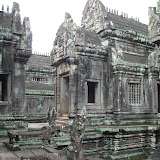 |
| Angkor last day |












